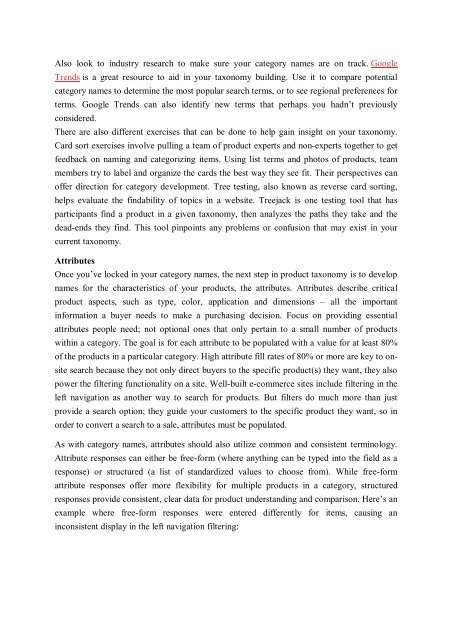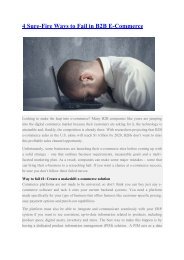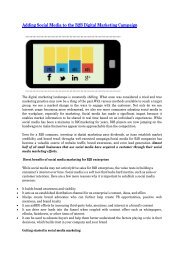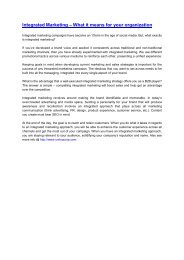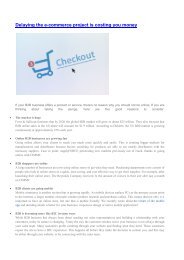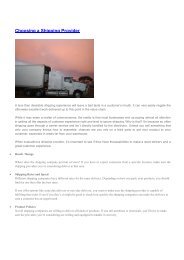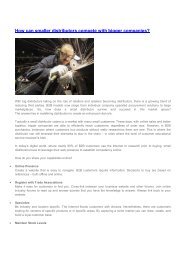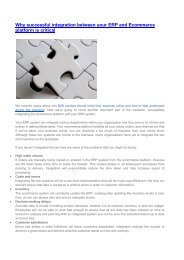Build a Clear Path to Your Products Online with Good Taxonomy
It may sound like a highly scientific term, but taxonomy is actually a pretty simple concept when it comes to e-commerce: it involves creating a logical classification of products and their characteristics so customers can easily shop for and find them in your online store. A good taxonomy leads people to your products in as few clicks as possible. The fewer the clicks, the faster the sale.
It may sound like a highly scientific term, but taxonomy is actually a pretty simple concept when it comes to e-commerce: it involves creating a logical classification of products and their characteristics so customers can easily shop for and find them in your online store. A good taxonomy leads people to your products in as few clicks as possible. The fewer the clicks, the faster the sale.
Create successful ePaper yourself
Turn your PDF publications into a flip-book with our unique Google optimized e-Paper software.
Also look <strong>to</strong> industry research <strong>to</strong> make sure your category names are on track. Google<br />
Trends is a great resource <strong>to</strong> aid in your taxonomy building. Use it <strong>to</strong> compare potential<br />
category names <strong>to</strong> determine the most popular search terms, or <strong>to</strong> see regional preferences for<br />
terms. Google Trends can also identify new terms that perhaps you hadn’t previously<br />
considered.<br />
There are also different exercises that can be done <strong>to</strong> help gain insight on your taxonomy.<br />
Card sort exercises involve pulling a team of product experts and non-experts <strong>to</strong>gether <strong>to</strong> get<br />
feedback on naming and categorizing items. Using list terms and pho<strong>to</strong>s of products, team<br />
members try <strong>to</strong> label and organize the cards the best way they see fit. Their perspectives can<br />
offer direction for category development. Tree testing, also known as reverse card sorting,<br />
helps evaluate the findability of <strong>to</strong>pics in a website. Treejack is one testing <strong>to</strong>ol that has<br />
participants find a product in a given taxonomy, then analyzes the paths they take and the<br />
dead-ends they find. This <strong>to</strong>ol pinpoints any problems or confusion that may exist in your<br />
current taxonomy.<br />
Attributes<br />
Once you’ve locked in your category names, the next step in product taxonomy is <strong>to</strong> develop<br />
names for the characteristics of your products, the attributes. Attributes describe critical<br />
product aspects, such as type, color, application and dimensions – all the important<br />
information a buyer needs <strong>to</strong> make a purchasing decision. Focus on providing essential<br />
attributes people need; not optional ones that only pertain <strong>to</strong> a small number of products<br />
<strong>with</strong>in a category. The goal is for each attribute <strong>to</strong> be populated <strong>with</strong> a value for at least 80%<br />
of the products in a particular category. High attribute fill rates of 80% or more are key <strong>to</strong> onsite<br />
search because they not only direct buyers <strong>to</strong> the specific product(s) they want, they also<br />
power the filtering functionality on a site. Well-built e-commerce sites include filtering in the<br />
left navigation as another way <strong>to</strong> search for products. But filters do much more than just<br />
provide a search option; they guide your cus<strong>to</strong>mers <strong>to</strong> the specific product they want, so in<br />
order <strong>to</strong> convert a search <strong>to</strong> a sale, attributes must be populated.<br />
As <strong>with</strong> category names, attributes should also utilize common and consistent terminology.<br />
Attribute responses can either be free-form (where anything can be typed in<strong>to</strong> the field as a<br />
response) or structured (a list of standardized values <strong>to</strong> choose from). While free-form<br />
attribute responses offer more flexibility for multiple products in a category, structured<br />
responses provide consistent, clear data for product understanding and comparison. Here’s an<br />
example where free-form responses were entered differently for items, causing an<br />
inconsistent display in the left navigation filtering:


